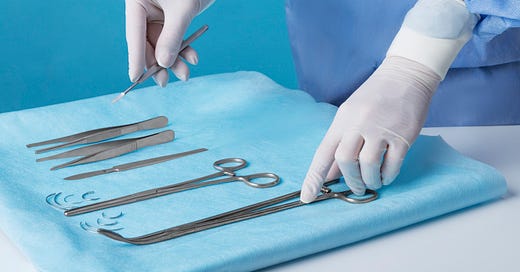“Blue Wrap” Recycling
What is "Blue Wrap" and how can it be a key sustainability initiative in your healthcare facility?
What is Blue Wrap?
Blue wrap is a tough polypropylene plastic wrap used to maintain the sterility of surgical instruments used in operating rooms. The common blue color and durable material is what gives blue wrap its name.
Local sterile processing departments and surgical instrument suppliers tightly enclose sterile supplies in the blue wrap to maintain the instrument’s sterility. The blue wrap ends up in operating rooms where OR staff unwrap the instruments for each case and discard the blue wrap.
Why is Blue Wrap Important for Sustainability?
Blue wrap cannot be recycled by municipal material recovery facilities, and therefore must be recycled by specialty processors. The mechanical recycling process melts and pelletizes the plastic wrap for reuse. The pelletized wrap can be remanufactured into new polypropylene plastic products that can be recycled in a closed-loop recycling process.
Healthcare sustainability leader, Practice Greenhealth, estimates 225 million pounds of blue wrap is thrown out each year1. Unlike soiled gloves or thin Ziploc bags, blue wrap is a high quality plastic product that can be easily recycled. The sterility of the product, if maintained uncontaminated, makes collection and remanufacturing easy and cost effective. Almost every acute care healthcare organization uses blue wrap in surgical settings. Recycling this product not only keeps millions of pounds from entering the landfill, but also provides an excellent raw material for plastics manufacturing – decreasing the need to further drill and refine oil into plastic.
Setup a Blue Wrap Collection Program
The key to implementing a new waste stream collection process is predicated on a reliable partnership with the collection vendor and aligned internal stakeholders. A suitable vendor could already be visiting your facility frequently such as an existing supplier or waste hauler. Their pickup frequency should match your blue wrap waste volume, ensuring timely pickups and proper throughput of the waste. If your organization reports on sustainability initiatives, you may ask the vendor to weigh the blue wrap and report on your waste diversion metrics.
The internal stakeholder group can include custodial services, OR staff, infection control, and shipping/receiving. This team should organize and document the flow of blue wrap from purchase to vendor pickup. The internal stakeholders will manage OR staff education, transportation to a pickup site, storage in an infection control approved location, and oversight of the vendor pickup.
Education is instrumental in the blue wrap collection implementation. OR staff should be informed of the new program, trained on the collection process, and excited to be apart of this sustainability initiative. OR staff should properly segregate the blue wrap and ensure no cross-contamination in the collection bins, which will yield the best recycling output and a safer process for those handling the blue wrap. Above all, staff should know that their collection efforts are contributing towards a clean, useful recycling procedure that benefits the environment.
“Blue Wrap and the Circular Economy,” Practice Greenhealth, November 1, 2018, https://practicegreenhealth.org/about/news/blue-wrap-and-circular-economy



